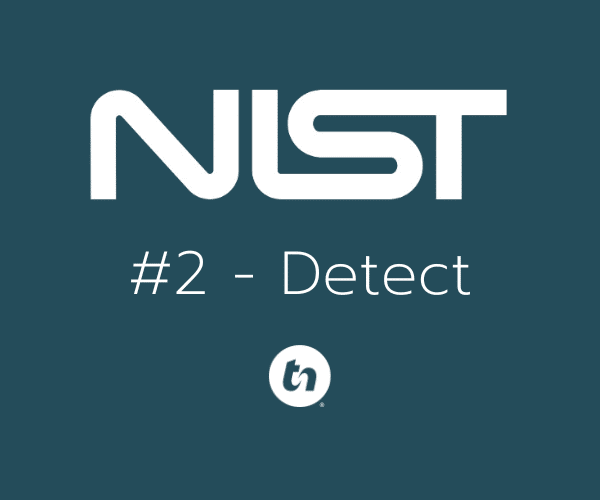Today, in our multipart series around the National Institute of Standards and Technology (NIST) Cybersecurity Framework – we cover the Detect pillar. If you are unfamiliar with NIST and their Cybersecurity Framework (CSF), it is a comprehensive guideline designed by the National Institute of Standards and Technology to help organizations manage and reduce their cybersecurity risk.

This framework is widely adopted across various industries due to its thorough approach to cybersecurity and is built around five core pillars (soon to be six): Identify, Protect, Detect, Respond, and Recover.
This article provides an overview of these pillars and dives deeper into the Detect pillar, explaining its components and significance.
Overview of the NIST Cybersecurity Framework Pillars
- Identify: Establishes the organizational understanding to manage cybersecurity risk to systems, people, assets, data, and capabilities.
- Protect: Develops and implements appropriate safeguards to ensure the delivery of critical infrastructure services.
- Detect: Develops and implements appropriate activities to identify the occurrence of a cybersecurity event.
- Respond: Develops and implements appropriate activities to act regarding a detected cybersecurity event.
- Recover: Develops and implements appropriate activities to maintain plans for resilience and restore any capabilities or services impaired due to a cybersecurity event.
The Detect Pillar: In-Depth
The Detect pillar is essential for recognizing the occurrence of cybersecurity events in a timely manner. This pillar focuses on the implementation of activities and mechanisms that can identify cybersecurity incidents promptly, enabling organizations to mitigate potential damage quickly. The Detect function is broken down into several key categories:
Anomalies and Events:
Detection Processes: Establishing and maintaining processes to detect anomalies and events.
Event Analysis: Analyzing detected events to understand the impact and response required.
Event Correlation: Correlating detected events to identify potential cybersecurity incidents.
Security Continuous Monitoring:
Network Monitoring: Monitoring network traffic to detect potential security incidents. This is typically done via your firewall and may require certain settings and configurations to do so.
Physical Environment Monitoring: Monitoring the physical environment to detect security events. This includes solutions such as camera systems or card access systems to monitor entry and exit from a facility.
Personnel Activity Monitoring: Monitoring user activity to identify suspicious behavior.
Vulnerability Monitoring: Continuously monitoring for vulnerabilities that could be exploited.
Detection Processes:
Establishing Detection Systems: Developing and implementing systems to detect cybersecurity events. This can include a Managed Detection and Response (MDR) solution, a robust spam filter to keep your mailboxes clean or email monitoring to identify any odd or suspicious behaviors in your mailbox such as overseas login attempts or administrator abuse.
Testing and Updating: Regularly testing and updating detection systems to ensure effectiveness. CISA offers various tools to assist you in testing your environment assuming you are eligible.
Alert Generation: Ensuring detection systems generate timely and actionable alerts. In the case of ThrottleNet, our solution notifies our dedicated cybersecurity team which then reviews the findings and takes any required action to mitigate any identified risk.
How the Detect Pillar Benefits Organizations
The Detect pillar is critical because it allows organizations to identify cybersecurity events swiftly, minimizing the potential impact. Here’s what it entails for an organization:
- Proactive Monitoring: By continuously monitoring networks, physical environments, and user activities, organizations can detect anomalies that may indicate a security incident. This proactive approach helps in identifying threats before they can cause significant damage.
- Timely Alerts: Effective detection processes generate timely alerts, enabling security teams to respond quickly to potential threats. This rapid response is crucial in mitigating the impact of cybersecurity incidents.
- Incident Analysis: Analyzing detected events helps organizations understand the nature and scope of potential incidents. This analysis is essential for determining the appropriate response and for improving future detection capabilities.
- Vulnerability Identification: Continuous monitoring for vulnerabilities ensures that organizations can address weaknesses before they are exploited by attackers. This proactive approach is vital for maintaining a robust security posture.
- Correlated Detection: By correlating various detected events, organizations can identify complex attack patterns that might not be apparent from individual events. This correlation helps in understanding the broader context of security incidents.
The Detect pillar of the NIST Cybersecurity Framework is a cornerstone for maintaining an effective cybersecurity posture. By focusing on the detection of anomalies, continuous monitoring, and the establishment of robust detection processes, organizations can identify and respond to cybersecurity incidents promptly. This proactive detection capability is essential for minimizing the impact of attacks and ensuring the security and resilience of an organization’s information systems.

Chris Montgomery
ThrottleNet Sales Director
cmontgomery@throttlenet.com



